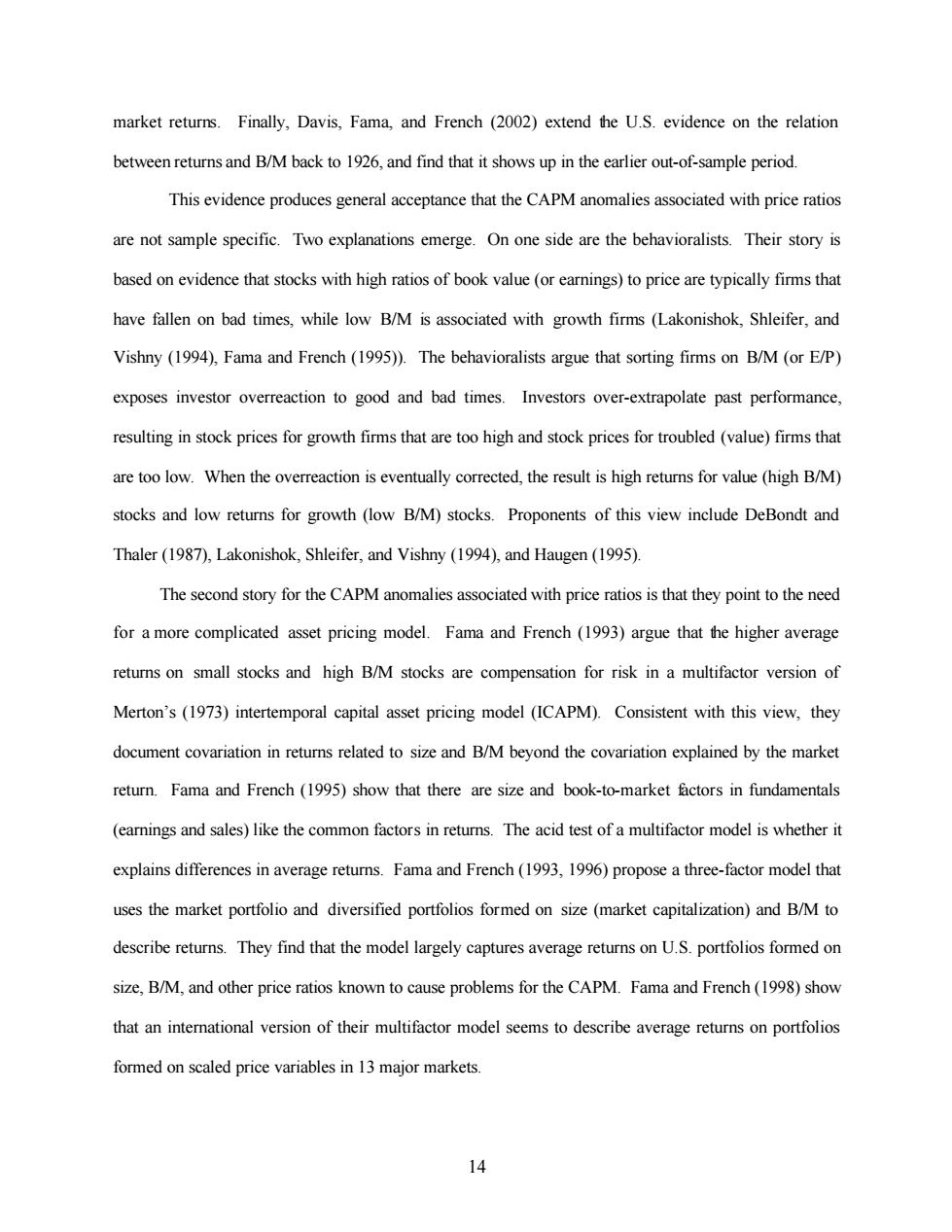正在加载图片...

market returns.Finally,Davis,Fama,and French (2002)extend the U.S.evidence on the relation between returns and B/M back to 1926,and find that it shows up in the earlier out-of-sample period. This evidence produces general acceptance that the CAPM anomalies associated with price ratios are not sample specific.Two explanations emerge.On one side are the behavioralists.Their story is based on evidence that stocks with high ratios of book value (or earnings)to price are typically firms that have fallen on bad times,while low B/M is associated with growth firms (Lakonishok,Shleifer,and Vishny (1994),Fama and French(1995)).The behavioralists argue that sorting firms on B/M(or E/P) exposes investor overreaction to good and bad times.Investors over-extrapolate past performance, resulting in stock prices for growth firms that are too high and stock prices for troubled(value)firms that are too low.When the overreaction is eventually corrected,the result is high returns for value(high B/M) stocks and low returns for growth (low B/M)stocks.Proponents of this view include DeBondt and Thaler(1987),Lakonishok,Shleifer,and Vishny (1994),and Haugen(1995). The second story for the CAPM anomalies associated with price ratios is that they point to the need for a more complicated asset pricing model.Fama and French(1993)argue that the higher average returns on small stocks and high B/M stocks are compensation for risk in a multifactor version of Merton's(1973)intertemporal capital asset pricing model (ICAPM).Consistent with this view,they document covariation in returns related to size and B/M beyond the covariation explained by the market return.Fama and French (1995)show that there are size and book-to-market factors in fundamentals (earnings and sales)like the common factors in returns.The acid test of a multifactor model is whether it explains differences in average returns.Fama and French(1993,1996)propose a three-factor model that uses the market portfolio and diversified portfolios formed on size (market capitalization)and B/M to describe returns.They find that the model largely captures average returns on U.S.portfolios formed on size,B/M,and other price ratios known to cause problems for the CAPM.Fama and French(1998)show that an international version of their multifactor model seems to describe average returns on portfolios formed on scaled price variables in 13 major markets. 1414 market returns. Finally, Davis, Fama, and French (2002) extend the U.S. evidence on the relation between returns and B/M back to 1926, and find that it shows up in the earlier out-of-sample period. This evidence produces general acceptance that the CAPM anomalies associated with price ratios are not sample specific. Two explanations emerge. On one side are the behavioralists. Their story is based on evidence that stocks with high ratios of book value (or earnings) to price are typically firms that have fallen on bad times, while low B/M is associated with growth firms (Lakonishok, Shleifer, and Vishny (1994), Fama and French (1995)). The behavioralists argue that sorting firms on B/M (or E/P) exposes investor overreaction to good and bad times. Investors over-extrapolate past performance, resulting in stock prices for growth firms that are too high and stock prices for troubled (value) firms that are too low. When the overreaction is eventually corrected, the result is high returns for value (high B/M) stocks and low returns for growth (low B/M) stocks. Proponents of this view include DeBondt and Thaler (1987), Lakonishok, Shleifer, and Vishny (1994), and Haugen (1995). The second story for the CAPM anomalies associated with price ratios is that they point to the need for a more complicated asset pricing model. Fama and French (1993) argue that the higher average returns on small stocks and high B/M stocks are compensation for risk in a multifactor version of Merton’s (1973) intertemporal capital asset pricing model (ICAPM). Consistent with this view, they document covariation in returns related to size and B/M beyond the covariation explained by the market return. Fama and French (1995) show that there are size and book-to-market factors in fundamentals (earnings and sales) like the common factors in returns. The acid test of a multifactor model is whether it explains differences in average returns. Fama and French (1993, 1996) propose a three-factor model that uses the market portfolio and diversified portfolios formed on size (market capitalization) and B/M to describe returns. They find that the model largely captures average returns on U.S. portfolios formed on size, B/M, and other price ratios known to cause problems for the CAPM. Fama and French (1998) show that an international version of their multifactor model seems to describe average returns on portfolios formed on scaled price variables in 13 major markets